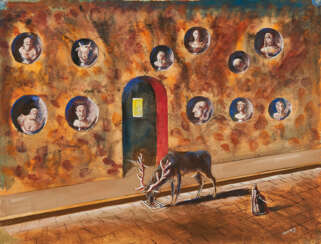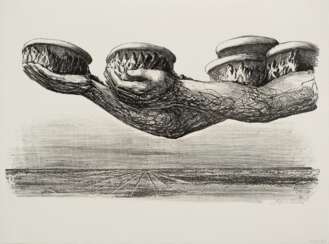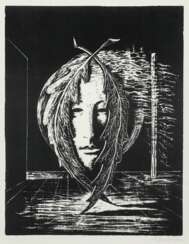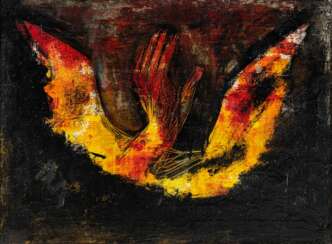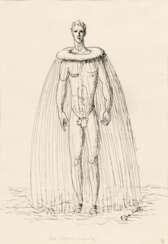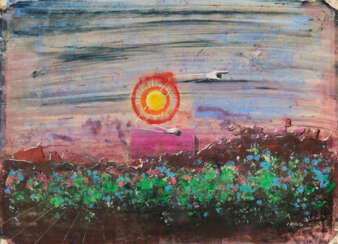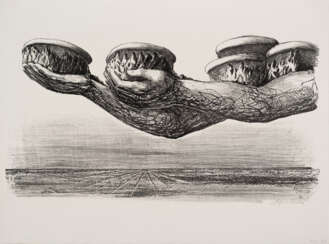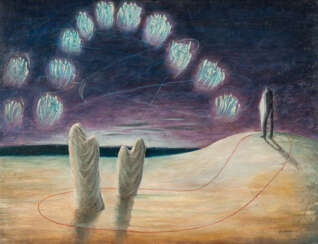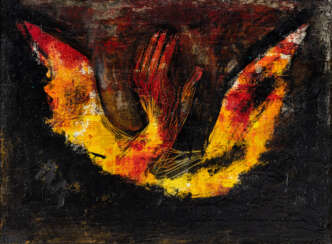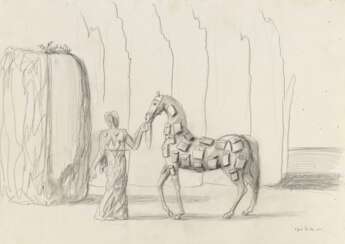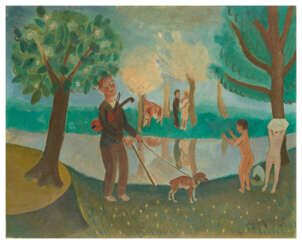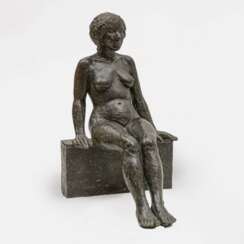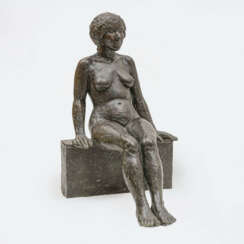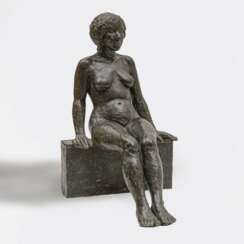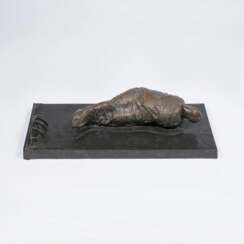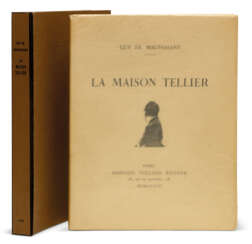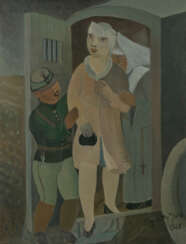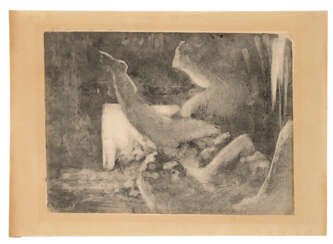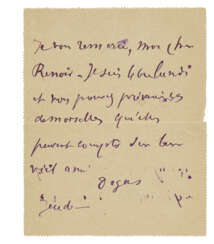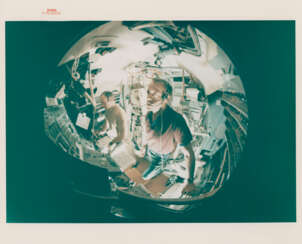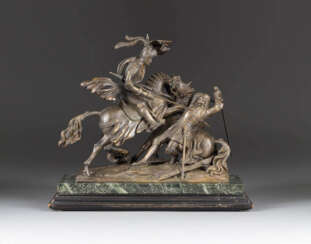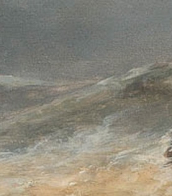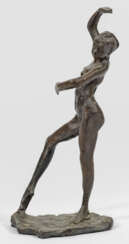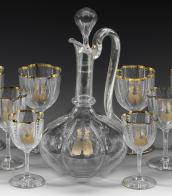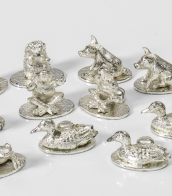edgar ende
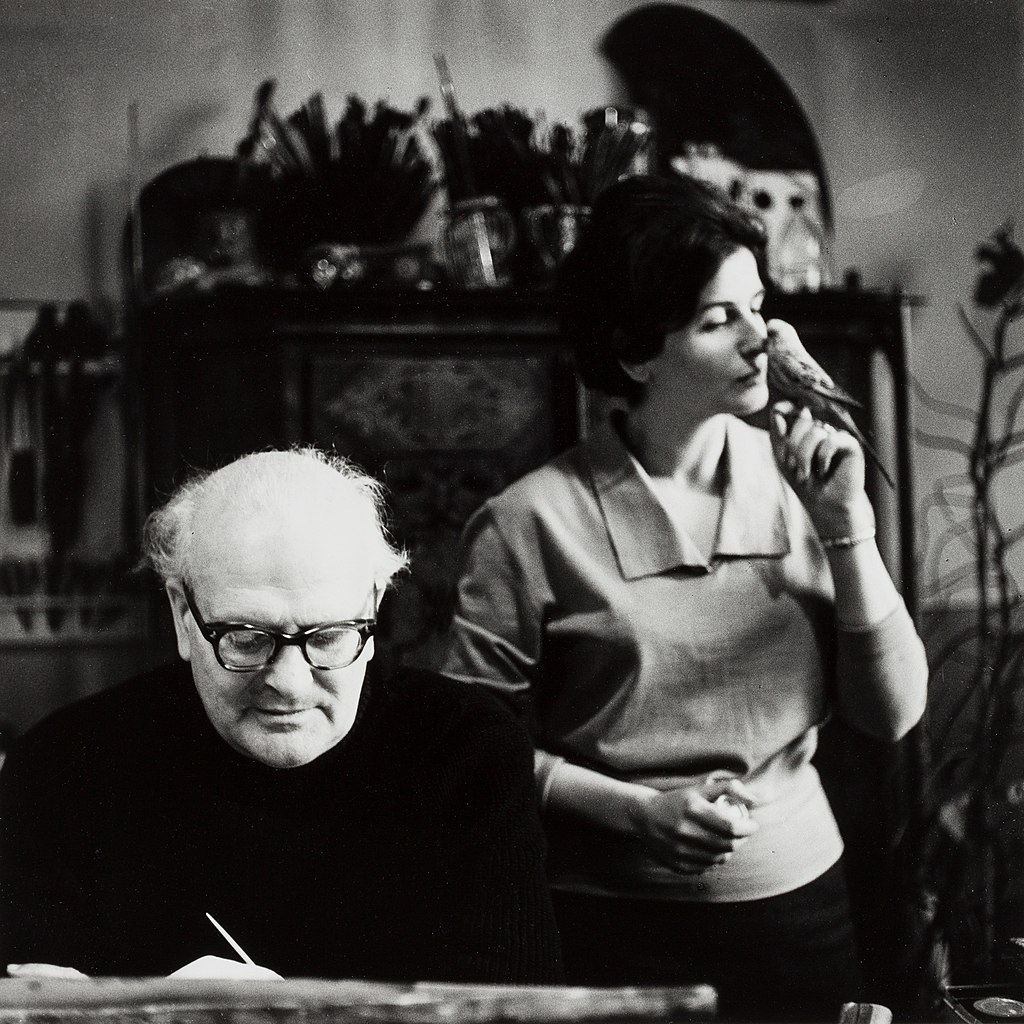
Edgar Carl Alfons Ende was a German surrealist painter, father of children's author Michael Ende and member of the Munich Secession.
Edgar Ende's work belongs to the tradition of fantasy and visionary art, and is considered one of the most important contributions of twentieth-century German painting to this style.
By the end of 1936 his paintings were considered 'degenerate art', and his work and exhibitions were banned by the Nazi regime. After the end of the war, Edgar Ende was one of the co-founders of the professional association of Munich artists, and for the first time participated in the Venice Biennale.
Since 1963 he has been an honorary member of the Academy of Fine Arts in Munich.
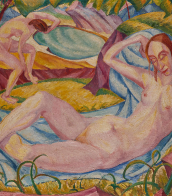

Edgar Carl Alfons Ende was a German surrealist painter, father of children's author Michael Ende and member of the Munich Secession.
Edgar Ende's work belongs to the tradition of fantasy and visionary art, and is considered one of the most important contributions of twentieth-century German painting to this style.
By the end of 1936 his paintings were considered 'degenerate art', and his work and exhibitions were banned by the Nazi regime. After the end of the war, Edgar Ende was one of the co-founders of the professional association of Munich artists, and for the first time participated in the Venice Biennale.
Since 1963 he has been an honorary member of the Academy of Fine Arts in Munich.
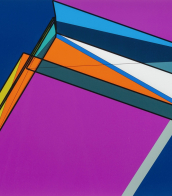

Edgar Carl Alfons Ende was a German surrealist painter, father of children's author Michael Ende and member of the Munich Secession.
Edgar Ende's work belongs to the tradition of fantasy and visionary art, and is considered one of the most important contributions of twentieth-century German painting to this style.
By the end of 1936 his paintings were considered 'degenerate art', and his work and exhibitions were banned by the Nazi regime. After the end of the war, Edgar Ende was one of the co-founders of the professional association of Munich artists, and for the first time participated in the Venice Biennale.
Since 1963 he has been an honorary member of the Academy of Fine Arts in Munich.


Edgar Carl Alfons Ende was a German surrealist painter, father of children's author Michael Ende and member of the Munich Secession.
Edgar Ende's work belongs to the tradition of fantasy and visionary art, and is considered one of the most important contributions of twentieth-century German painting to this style.
By the end of 1936 his paintings were considered 'degenerate art', and his work and exhibitions were banned by the Nazi regime. After the end of the war, Edgar Ende was one of the co-founders of the professional association of Munich artists, and for the first time participated in the Venice Biennale.
Since 1963 he has been an honorary member of the Academy of Fine Arts in Munich.


Edgar Carl Alfons Ende was a German surrealist painter, father of children's author Michael Ende and member of the Munich Secession.
Edgar Ende's work belongs to the tradition of fantasy and visionary art, and is considered one of the most important contributions of twentieth-century German painting to this style.
By the end of 1936 his paintings were considered 'degenerate art', and his work and exhibitions were banned by the Nazi regime. After the end of the war, Edgar Ende was one of the co-founders of the professional association of Munich artists, and for the first time participated in the Venice Biennale.
Since 1963 he has been an honorary member of the Academy of Fine Arts in Munich.


Edgar Carl Alfons Ende was a German surrealist painter, father of children's author Michael Ende and member of the Munich Secession.
Edgar Ende's work belongs to the tradition of fantasy and visionary art, and is considered one of the most important contributions of twentieth-century German painting to this style.
By the end of 1936 his paintings were considered 'degenerate art', and his work and exhibitions were banned by the Nazi regime. After the end of the war, Edgar Ende was one of the co-founders of the professional association of Munich artists, and for the first time participated in the Venice Biennale.
Since 1963 he has been an honorary member of the Academy of Fine Arts in Munich.


Edgar Carl Alfons Ende was a German surrealist painter, father of children's author Michael Ende and member of the Munich Secession.
Edgar Ende's work belongs to the tradition of fantasy and visionary art, and is considered one of the most important contributions of twentieth-century German painting to this style.
By the end of 1936 his paintings were considered 'degenerate art', and his work and exhibitions were banned by the Nazi regime. After the end of the war, Edgar Ende was one of the co-founders of the professional association of Munich artists, and for the first time participated in the Venice Biennale.
Since 1963 he has been an honorary member of the Academy of Fine Arts in Munich.


Edgar Carl Alfons Ende was a German surrealist painter, father of children's author Michael Ende and member of the Munich Secession.
Edgar Ende's work belongs to the tradition of fantasy and visionary art, and is considered one of the most important contributions of twentieth-century German painting to this style.
By the end of 1936 his paintings were considered 'degenerate art', and his work and exhibitions were banned by the Nazi regime. After the end of the war, Edgar Ende was one of the co-founders of the professional association of Munich artists, and for the first time participated in the Venice Biennale.
Since 1963 he has been an honorary member of the Academy of Fine Arts in Munich.


Edgar Carl Alfons Ende was a German surrealist painter, father of children's author Michael Ende and member of the Munich Secession.
Edgar Ende's work belongs to the tradition of fantasy and visionary art, and is considered one of the most important contributions of twentieth-century German painting to this style.
By the end of 1936 his paintings were considered 'degenerate art', and his work and exhibitions were banned by the Nazi regime. After the end of the war, Edgar Ende was one of the co-founders of the professional association of Munich artists, and for the first time participated in the Venice Biennale.
Since 1963 he has been an honorary member of the Academy of Fine Arts in Munich.


Edgar Carl Alfons Ende was a German surrealist painter, father of children's author Michael Ende and member of the Munich Secession.
Edgar Ende's work belongs to the tradition of fantasy and visionary art, and is considered one of the most important contributions of twentieth-century German painting to this style.
By the end of 1936 his paintings were considered 'degenerate art', and his work and exhibitions were banned by the Nazi regime. After the end of the war, Edgar Ende was one of the co-founders of the professional association of Munich artists, and for the first time participated in the Venice Biennale.
Since 1963 he has been an honorary member of the Academy of Fine Arts in Munich.


Edgar Carl Alfons Ende was a German surrealist painter, father of children's author Michael Ende and member of the Munich Secession.
Edgar Ende's work belongs to the tradition of fantasy and visionary art, and is considered one of the most important contributions of twentieth-century German painting to this style.
By the end of 1936 his paintings were considered 'degenerate art', and his work and exhibitions were banned by the Nazi regime. After the end of the war, Edgar Ende was one of the co-founders of the professional association of Munich artists, and for the first time participated in the Venice Biennale.
Since 1963 he has been an honorary member of the Academy of Fine Arts in Munich.
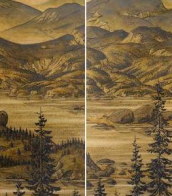

Edgar Carl Alfons Ende was a German surrealist painter, father of children's author Michael Ende and member of the Munich Secession.
Edgar Ende's work belongs to the tradition of fantasy and visionary art, and is considered one of the most important contributions of twentieth-century German painting to this style.
By the end of 1936 his paintings were considered 'degenerate art', and his work and exhibitions were banned by the Nazi regime. After the end of the war, Edgar Ende was one of the co-founders of the professional association of Munich artists, and for the first time participated in the Venice Biennale.
Since 1963 he has been an honorary member of the Academy of Fine Arts in Munich.


Edgar Carl Alfons Ende was a German surrealist painter, father of children's author Michael Ende and member of the Munich Secession.
Edgar Ende's work belongs to the tradition of fantasy and visionary art, and is considered one of the most important contributions of twentieth-century German painting to this style.
By the end of 1936 his paintings were considered 'degenerate art', and his work and exhibitions were banned by the Nazi regime. After the end of the war, Edgar Ende was one of the co-founders of the professional association of Munich artists, and for the first time participated in the Venice Biennale.
Since 1963 he has been an honorary member of the Academy of Fine Arts in Munich.


Edgar Carl Alfons Ende was a German surrealist painter, father of children's author Michael Ende and member of the Munich Secession.
Edgar Ende's work belongs to the tradition of fantasy and visionary art, and is considered one of the most important contributions of twentieth-century German painting to this style.
By the end of 1936 his paintings were considered 'degenerate art', and his work and exhibitions were banned by the Nazi regime. After the end of the war, Edgar Ende was one of the co-founders of the professional association of Munich artists, and for the first time participated in the Venice Biennale.
Since 1963 he has been an honorary member of the Academy of Fine Arts in Munich.


Edgar Carl Alfons Ende was a German surrealist painter, father of children's author Michael Ende and member of the Munich Secession.
Edgar Ende's work belongs to the tradition of fantasy and visionary art, and is considered one of the most important contributions of twentieth-century German painting to this style.
By the end of 1936 his paintings were considered 'degenerate art', and his work and exhibitions were banned by the Nazi regime. After the end of the war, Edgar Ende was one of the co-founders of the professional association of Munich artists, and for the first time participated in the Venice Biennale.
Since 1963 he has been an honorary member of the Academy of Fine Arts in Munich.

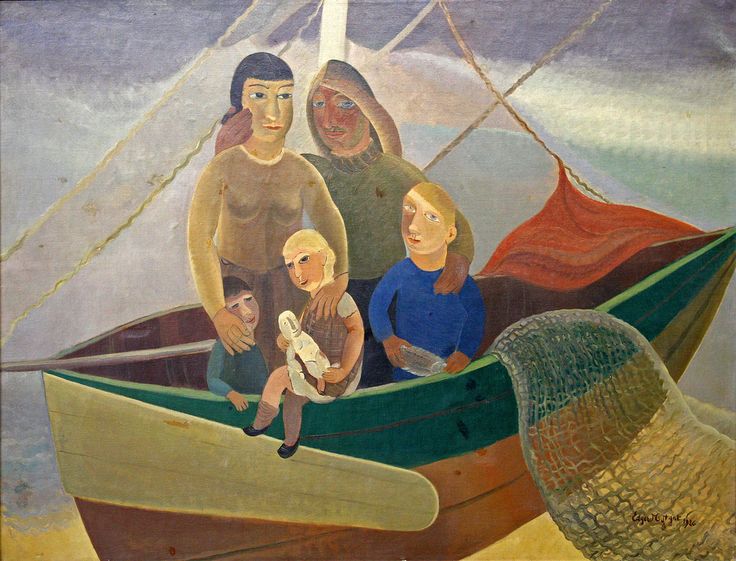
Edgard Tytgat is a Belgian painter, engraver, illustrator, draftsman, etcher, watercolourist and wood engraver. As an engraver and xylographer, he illustrated numerous works. His painting, in a style inspired by Post-Impressionism, is often described as naive painting, with scenes of daily life, interiors, fairs, lovers, but not devoid of sweet poetry. From 1950, he approached the representation of mythological legends sometimes bathed in a certain eroticism. Edgard Tytgat has participated in numerous exhibitions, both personal and collective, in Belgium and abroad.

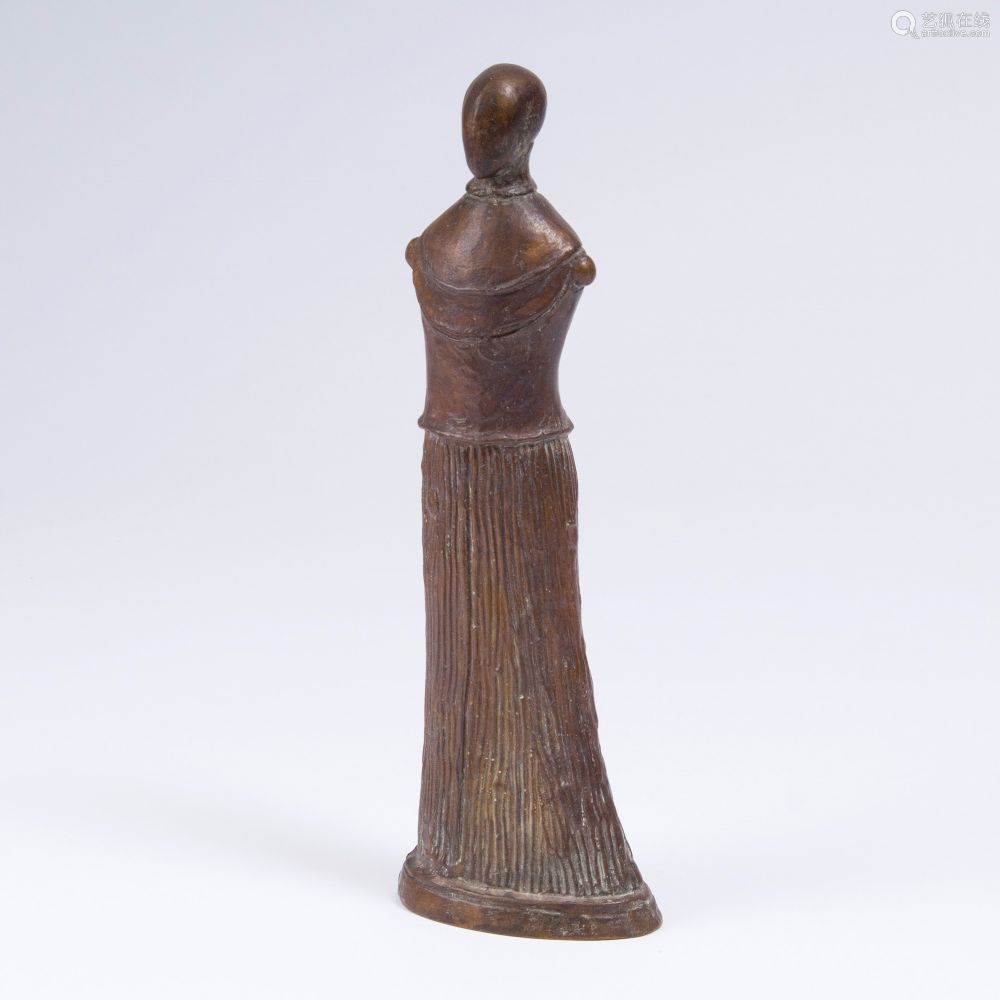
Edgar Augustin was a German painter and sculptor.
Augustin studied sculpture in Münster with Karl Ehlers, then was a pupil of the master Gustav Zeitz in Hamburg. His oeuvre includes partly abstract figurative representations in bronze, wood and plaster as well as paintings, drawings and graphics. Some of Edgar Augustine's sculptures are located in public spaces in Hamburg and other cities.
Edgar Augustin was a member of the Free Academy of Arts in Hamburg and the Special Association of Artists in Germany. In the second half of the 20th century, Augustin was one of the pioneers of figurative wood sculpture and is considered its most important representative.


Edgar Augustin was a German painter and sculptor.
Augustin studied sculpture in Münster with Karl Ehlers, then was a pupil of the master Gustav Zeitz in Hamburg. His oeuvre includes partly abstract figurative representations in bronze, wood and plaster as well as paintings, drawings and graphics. Some of Edgar Augustine's sculptures are located in public spaces in Hamburg and other cities.
Edgar Augustin was a member of the Free Academy of Arts in Hamburg and the Special Association of Artists in Germany. In the second half of the 20th century, Augustin was one of the pioneers of figurative wood sculpture and is considered its most important representative.
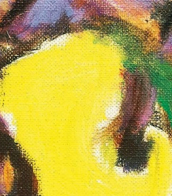

Edgar Augustin was a German painter and sculptor.
Augustin studied sculpture in Münster with Karl Ehlers, then was a pupil of the master Gustav Zeitz in Hamburg. His oeuvre includes partly abstract figurative representations in bronze, wood and plaster as well as paintings, drawings and graphics. Some of Edgar Augustine's sculptures are located in public spaces in Hamburg and other cities.
Edgar Augustin was a member of the Free Academy of Arts in Hamburg and the Special Association of Artists in Germany. In the second half of the 20th century, Augustin was one of the pioneers of figurative wood sculpture and is considered its most important representative.


Edgar Augustin was a German painter and sculptor.
Augustin studied sculpture in Münster with Karl Ehlers, then was a pupil of the master Gustav Zeitz in Hamburg. His oeuvre includes partly abstract figurative representations in bronze, wood and plaster as well as paintings, drawings and graphics. Some of Edgar Augustine's sculptures are located in public spaces in Hamburg and other cities.
Edgar Augustin was a member of the Free Academy of Arts in Hamburg and the Special Association of Artists in Germany. In the second half of the 20th century, Augustin was one of the pioneers of figurative wood sculpture and is considered its most important representative.
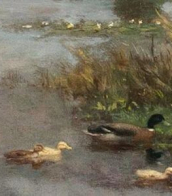

Edgar Degas, a French artist, was a master of painting, sculpture, and drawing, celebrated for his profound influence on the Impressionist movement despite his preference for being called a realist. Degas was born into a well-off family in Paris, France, and demonstrated a keen interest in art from an early age, eventually shaping his path to become one of the most sophisticated draftsmen of his time. His rigorous academic training and close study of classical art initially aimed him towards a career in history painting, but Degas soon pivoted towards contemporary subject matter, thus cementing his role as a classical painter of modern life.
Degas is renowned for his dynamic portrayals of movement, particularly in his depictions of dancers, racehorses, and everyday Parisian life. His works are characterized by their psychological depth and the isolation of his figures, showcasing his unique ability to capture the essence of his subjects with both empathy and critical distance. More than half of his oeuvre focuses on dancers, reflecting not only his fascination with the ballet but also his innovative approach to composition and form. This focus on the human figure, explored in various media including oil, pastel, and sculpture, underscores Degas's commitment to studying the nuances of human movement and expression.
Degas's artistic career is marked by his experimentation with various techniques and materials, as seen in his bronze sculptures and pastel nudes. One of his most famous sculptures, the study of the young ballet student Marie van Goethem, showcases his pioneering use of real objects in sculpture, a practice that prefigured later artistic innovations. Despite the controversies that sometimes surrounded his work, particularly in his depictions of the female nude, Degas's legacy as an artist who bridged the gap between traditional academic art and the modern movements of the early 20th century remains undisputed.
For collectors and experts in art and antiques, Degas's work offers a fascinating study in the evolution of modern art, highlighting the artist's deep engagement with the cultural and social dynamics of his time. His pieces, whether in the form of paintings, sculptures, or prints, continue to captivate audiences with their complexity, beauty, and innovative spirit.
If you are keen to stay updated on sales and auction events related to Edgar Degas, signing up for updates is a prudent choice. This subscription service ensures that you remain informed about new opportunities to acquire works by this pivotal figure in the art world, without overwhelming you with unnecessary information.


Edgar Augustin was a German painter and sculptor.
Augustin studied sculpture in Münster with Karl Ehlers, then was a pupil of the master Gustav Zeitz in Hamburg. His oeuvre includes partly abstract figurative representations in bronze, wood and plaster as well as paintings, drawings and graphics. Some of Edgar Augustine's sculptures are located in public spaces in Hamburg and other cities.
Edgar Augustin was a member of the Free Academy of Arts in Hamburg and the Special Association of Artists in Germany. In the second half of the 20th century, Augustin was one of the pioneers of figurative wood sculpture and is considered its most important representative.
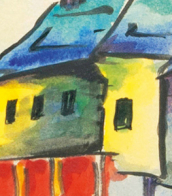

Edgard Tytgat is a Belgian painter, engraver, illustrator, draftsman, etcher, watercolourist and wood engraver. As an engraver and xylographer, he illustrated numerous works. His painting, in a style inspired by Post-Impressionism, is often described as naive painting, with scenes of daily life, interiors, fairs, lovers, but not devoid of sweet poetry. From 1950, he approached the representation of mythological legends sometimes bathed in a certain eroticism. Edgard Tytgat has participated in numerous exhibitions, both personal and collective, in Belgium and abroad.


Edgar Degas, a French artist, was a master of painting, sculpture, and drawing, celebrated for his profound influence on the Impressionist movement despite his preference for being called a realist. Degas was born into a well-off family in Paris, France, and demonstrated a keen interest in art from an early age, eventually shaping his path to become one of the most sophisticated draftsmen of his time. His rigorous academic training and close study of classical art initially aimed him towards a career in history painting, but Degas soon pivoted towards contemporary subject matter, thus cementing his role as a classical painter of modern life.
Degas is renowned for his dynamic portrayals of movement, particularly in his depictions of dancers, racehorses, and everyday Parisian life. His works are characterized by their psychological depth and the isolation of his figures, showcasing his unique ability to capture the essence of his subjects with both empathy and critical distance. More than half of his oeuvre focuses on dancers, reflecting not only his fascination with the ballet but also his innovative approach to composition and form. This focus on the human figure, explored in various media including oil, pastel, and sculpture, underscores Degas's commitment to studying the nuances of human movement and expression.
Degas's artistic career is marked by his experimentation with various techniques and materials, as seen in his bronze sculptures and pastel nudes. One of his most famous sculptures, the study of the young ballet student Marie van Goethem, showcases his pioneering use of real objects in sculpture, a practice that prefigured later artistic innovations. Despite the controversies that sometimes surrounded his work, particularly in his depictions of the female nude, Degas's legacy as an artist who bridged the gap between traditional academic art and the modern movements of the early 20th century remains undisputed.
For collectors and experts in art and antiques, Degas's work offers a fascinating study in the evolution of modern art, highlighting the artist's deep engagement with the cultural and social dynamics of his time. His pieces, whether in the form of paintings, sculptures, or prints, continue to captivate audiences with their complexity, beauty, and innovative spirit.
If you are keen to stay updated on sales and auction events related to Edgar Degas, signing up for updates is a prudent choice. This subscription service ensures that you remain informed about new opportunities to acquire works by this pivotal figure in the art world, without overwhelming you with unnecessary information.


Edgar Degas, a French artist, was a master of painting, sculpture, and drawing, celebrated for his profound influence on the Impressionist movement despite his preference for being called a realist. Degas was born into a well-off family in Paris, France, and demonstrated a keen interest in art from an early age, eventually shaping his path to become one of the most sophisticated draftsmen of his time. His rigorous academic training and close study of classical art initially aimed him towards a career in history painting, but Degas soon pivoted towards contemporary subject matter, thus cementing his role as a classical painter of modern life.
Degas is renowned for his dynamic portrayals of movement, particularly in his depictions of dancers, racehorses, and everyday Parisian life. His works are characterized by their psychological depth and the isolation of his figures, showcasing his unique ability to capture the essence of his subjects with both empathy and critical distance. More than half of his oeuvre focuses on dancers, reflecting not only his fascination with the ballet but also his innovative approach to composition and form. This focus on the human figure, explored in various media including oil, pastel, and sculpture, underscores Degas's commitment to studying the nuances of human movement and expression.
Degas's artistic career is marked by his experimentation with various techniques and materials, as seen in his bronze sculptures and pastel nudes. One of his most famous sculptures, the study of the young ballet student Marie van Goethem, showcases his pioneering use of real objects in sculpture, a practice that prefigured later artistic innovations. Despite the controversies that sometimes surrounded his work, particularly in his depictions of the female nude, Degas's legacy as an artist who bridged the gap between traditional academic art and the modern movements of the early 20th century remains undisputed.
For collectors and experts in art and antiques, Degas's work offers a fascinating study in the evolution of modern art, highlighting the artist's deep engagement with the cultural and social dynamics of his time. His pieces, whether in the form of paintings, sculptures, or prints, continue to captivate audiences with their complexity, beauty, and innovative spirit.
If you are keen to stay updated on sales and auction events related to Edgar Degas, signing up for updates is a prudent choice. This subscription service ensures that you remain informed about new opportunities to acquire works by this pivotal figure in the art world, without overwhelming you with unnecessary information.


Edgar Degas, a French artist, was a master of painting, sculpture, and drawing, celebrated for his profound influence on the Impressionist movement despite his preference for being called a realist. Degas was born into a well-off family in Paris, France, and demonstrated a keen interest in art from an early age, eventually shaping his path to become one of the most sophisticated draftsmen of his time. His rigorous academic training and close study of classical art initially aimed him towards a career in history painting, but Degas soon pivoted towards contemporary subject matter, thus cementing his role as a classical painter of modern life.
Degas is renowned for his dynamic portrayals of movement, particularly in his depictions of dancers, racehorses, and everyday Parisian life. His works are characterized by their psychological depth and the isolation of his figures, showcasing his unique ability to capture the essence of his subjects with both empathy and critical distance. More than half of his oeuvre focuses on dancers, reflecting not only his fascination with the ballet but also his innovative approach to composition and form. This focus on the human figure, explored in various media including oil, pastel, and sculpture, underscores Degas's commitment to studying the nuances of human movement and expression.
Degas's artistic career is marked by his experimentation with various techniques and materials, as seen in his bronze sculptures and pastel nudes. One of his most famous sculptures, the study of the young ballet student Marie van Goethem, showcases his pioneering use of real objects in sculpture, a practice that prefigured later artistic innovations. Despite the controversies that sometimes surrounded his work, particularly in his depictions of the female nude, Degas's legacy as an artist who bridged the gap between traditional academic art and the modern movements of the early 20th century remains undisputed.
For collectors and experts in art and antiques, Degas's work offers a fascinating study in the evolution of modern art, highlighting the artist's deep engagement with the cultural and social dynamics of his time. His pieces, whether in the form of paintings, sculptures, or prints, continue to captivate audiences with their complexity, beauty, and innovative spirit.
If you are keen to stay updated on sales and auction events related to Edgar Degas, signing up for updates is a prudent choice. This subscription service ensures that you remain informed about new opportunities to acquire works by this pivotal figure in the art world, without overwhelming you with unnecessary information.


